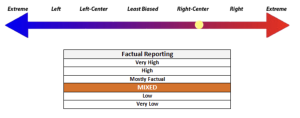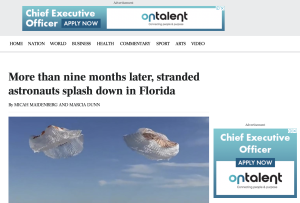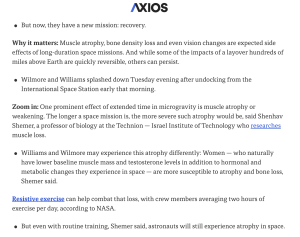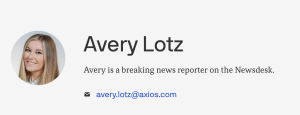
News Story 1: More than nine months later, stranded astronauts splash down in Florida (The Australian)
Biographical Analysis of the News Services
The Australian is an Australian national daily newspaper, which is a legacy media. The Australia founded in 1964 by Rupert Murdoch under his News Limited (now News Corp) media empire. It is the flagship newspaper of the News Corporation’s Australian division. As a part of News Corporation, it operates within a large commercial media conglomerate, funded primarily through advertising revenues, subscriptions, and syndication.
The Australian plays a crucial role in the Australian media system as a private, for-profit entity. Its status as a national daily places it among the leading newspapers in the country, often regarded as a conservative-leaning publication.

Media Bias/Fact Check rate The Australian as right-center bias. Its influence extends into both print and digital realms, reaching a wide audience across various platforms.
The Australian distinguishes itself with a commitment to business and political reporting.
-Example of political reporting:
-Example of an in-depth business News:
The target demographic of The Australian is typically educated and politically engaged readers, including business professionals, policymakers, and academics. According to figures reported by Elsworth (2023) in The Australian, its cross-platform monthly readership reached 4.152 million, 24% higher than that of rival Australian Financial Review. This shows that The Australian has a significant advantage in online subscriptions.
Comparative Analysis of News Coverage
1.Writing and Content Production
The Australian‘s article, “More Than Nine Months Later, Stranded Astronauts Finally Leave ISS,” demonstrates a formal and legacy writing style, adhering to traditional journalistic standards. The piece is based on the fact, relying on official sources such as NASA reports and statements from relevant authorities, ensuring credibility. Son (2022) suggested that online journalistic stories can be mixed with video, infographics, statistics and solid background data. The inserted video of the entire capsule splash down process, which lasted 2min23s shows the multimedia of online journalism. There are some share buttons below the article so readers could share this online coverage to Facebook and X(Twitter) directly. A modern multimedia news site functions as a central hub for real-time news and feature coverage, strategically designed for distribution across various digital platforms and social networks (Malik, A., & Shapiro, I., 2017).
Structurally, the article follows the inverted pyramid format, beginning with the most critical information—the astronauts’ return—before providing background details on their extended stay in space. This approach ensures readability and allows readers to grasp essential details quickly. However, the coverage lacks an in-depth narrative element, which could make the story more engaging for readers.
Consider using links and embedded media to add the extra background that print articles would normally be filled out with (Bradshaw, 2024). There are some hyperlinks inserted in the coverage to help readers understand the NASA mission background information. For example, “Sunday’s arrival of their relief crew” links to the coverage “SpaceX crew docks with ISS to bring stranded astronauts’ home,” which published in Mar 16,2025. “Stuck at work.” links to “SpaceX, NASA in crew-swap mission to return Starliner astronauts “this article covers which explain this phrase.
2.Online and Technical Delivery
Author contact options, such as direct email addresses or social media links, are not provided, making it difficult for readers to engage with journalists or seek clarifications. This lack of transparency and interactivity is in stark contrast to digital-born news platforms that emphasize the interaction between journalists and readers. Without these interactions of journalists and readers, news production becomes less collaborative or transparent. These interactions not only fuel creativity, but also have economic value, helping to drive traffic, broaden your audience, strengthen user loyalty, and drive subscription growth. Martin & Murrell (2021) argued that they may also enhance public trust in journalism and the professional practice of journalists. However, it is integrated with social media links for sharing and engaging via platforms like Facebook and X(Twitter). Social media posts are not embedded to enhance the article’s interactivity.
While there are no visible author-specific contact options, the platform offers a “Contact us” section that users can explore for further communication. Social media engagement helps the platform maintain interactivity and reach a broader audience.
The website is mobile-friendly, offering a responsive design that adapts well to different screen sizes. However, readability is hindered by intrusive pop-up ads and subscription paywalls, which disrupt the user experience. The following image shows pop-ups ads appear at the top and right side of the page. While this aligns with The Australian’s subscription-based revenue model, it may deter casual readers seeking immediate access to news content.

News Story 2: U.S. astronauts splash down: This is what microgravity does to your body (Axios)
https://www.axios.com/2025/03/18/health-impacts-space-nasa-wilmore-williams?utm_source=chatgpt.com
Biographical Analysis of the News Services
Axios is a digital-born American news platform which was established in 2016 and launched in 2017 by ex-Politico journalists Jim VandeHei, Mike Allen, and Roy Schwartz. The company is privately owned. Axios primarily funds its operations through digital advertising and paid subscription models. The launch of Axios Pro in 2022, which introduces three core reporting areas: Fintech, politics and technology, reflecting the company’s commitment to broadening its content offerings.
Axios specializes in delivering content that emphasizes accessibility. Axios‘ unique market position lies in offering concise articles that often feature key takeaways, bullet points, and graphics, which are ideal for busy readers.

For example, the coverage “U.S. astronauts splash down: This is what microgravity does to your body” uses serious of bullet points.
Axios‘ target audience is composed of professionals and informed readers who prioritize efficiency in news consumption. Axios has cultivated a dedicated readership by delivering concise, factual, and timely reporting, particularly in technology and politics, where staying informed is essential. This approach aligns with their Smart Brevity® methodology, which emphasizes delivering relevant updates clearly and efficiently, catering to readers’ time constraints and information needs.
Smart Brevity®:https://www.axioshq.com/insights/two-keys-to-keeping-busy-readers-engaged?utm_source=chatgpt.com
Additionally, Axios‘ use of user-level data to enhance engagement with its email newsletters demonstrates their commitment to understanding and serving their audience effectively.
Comparative Analysis of News Coverage
1.Writing and Content Production
The Axios coverage “Health Impacts of Space: NASA’s Wilmore and Williams” presents a well-researched and factual account of the physiological effects of space travel on astronauts. It cites credible sources, including NASA, and incorporates expert commentary.
The writing style is neutral and formal, reflecting Axios’ signature “smart brevity” approach. This coverage simplifies complex scientific concepts into clear, concise language, ensuring accessibility for a wide audience. Accessibility is a further benefit to making online journalism scannable (Bradshaw, 2024). These phrases in the coverage, such as “Why it matters; Zoom in; By the numbers; Fun fact; Zoom out; Yes, but…” are the clear examples. Rather than employing the extensive background analysis typical of investigative journalism, Axios prioritizes brevity while preserving informational depth.
Structurally, the coverage follows a hybrid format. It opens with a compelling lead summarizing the key findings These stories do not have to follow the inverted pyramid formula, which is the conventional structure more suited to spot stories and event-based news. Kulkarni et al. (2022) challenged the traditional belief and long-standing journalistic principle that the IP model is the most concise and effective method for delivering news to audiences. However, it also integrates elements of a narrative-driven approach, incorporating astronaut experiences and scientific insights to contextualize the broader implications of space travel on human health.
Compared with the coverage from The Australian, the amount of the hyperlinks is obviously larger. Hyperlinks to related studies and past reports enhance the article’s credibility by allowing readers to verify claims and explore additional context. The article is tagged with relevant keywords, aiding discoverability and search engine optimization. However, it lacks multimedia elements such as images or videos.
2.Online and Technical Delivery
Axios‘ online platform encourages reader engagement through social media integration. Unlike some digital-born outlets that embed social media posts for real-time context, Axios does not incorporate tweets or statements from NASA or astronauts within the article. The absence of such elements slightly reduces the piece’s dynamism and interactivity. The integration of social media into journalism is not just about social or technical tools for news production. It is about how these elements interact and create new possibilities for producing and sharing news and information (Bossio, 2017).
Axios offers author contact options, such as direct email links or social media profiles, in keeping with transparency-focused news platforms that encourage journalists to engage in dialogue with readers. By allowing direct access to journalists, Axios reinforces trust and accountability while maintaining its credibility through rigorous reporting.

Unlike traditional news sites, Axios minimizes intrusive ads and disruptive pop-ups, providing a smooth and uninterrupted reading experience. Its website is mobile-friendly and optimized for different screen sizes, ensuring accessibility across various devices. This design enhances usability and makes content consumption more seamless for readers.
From a technical standpoint, hyperlinks function correctly, directing readers to supplementary sources without navigation issues. The absence of multimedia elements such as videos or interactive graphics slightly limits the article’s engagement potential. Navigation remains intuitive, with related content and categories clearly organized to facilitate topic exploration.
(Approx. 1519 Words excluding references and sources)
References:
Elsworth, S. (2023, Aug 21). The Australian increases readership lead over Nine’s Australian Financial Review. The Australian. https://www.theaustralian.com.au/business/media/the-australian-increases-readership-lead-over-nines-australian-financial-review/news-story/b8f65fe6f24fc362b172915bca4a9040?utm_source=chatgpt.com.
Son, J. (2022). Online Journalism and Storytelling: A training kit. FOJO Media Institute. https://fojo.se/onlinejournalismkit/
Malik, A., & Shapiro, I. (2017). What’s Digital? What’s Journalism? In S. A. Eldridge & B. Franklin (Eds.), The Routledge Companion to Digital Journalism Studies (1st ed., pp. 15–24). Routledge. https://doi.org/10.4324/9781315713793-2
Bradshaw, P. (2024). Writing for social media. In ProQuest (Firm) (Ed.), The online journalism handbook: skills to survive and thrive in the digital age (Third edition., pp. 106–142). Routledge. https://doi.org/10.4324/9780429321566
Micah, M & Marcia, D. (2025, Mar 20). More than nine months later, stranded astronauts splash down in Florida. The Australian. https://www.theaustralian.com.au/world/more-than-nine-months-later-stranded-astronauts-finally-leave-iss/news-story/cd58762226b2660f328ff19291cfeedc
Martin, F., & Murrell, C. (2021). Negotiating the Conversation: How Journalists Learn to Interact with Audiences Online. Journalism Practice, 15(6), 839–859. https://doi.org/10.1080/17512786.2021.1907211
Avery, L. (2025, Mar 18). U.S. astronauts splash down: This is what microgravity does to your body. Axios. https://www.axios.com/2025/03/18/health-impacts-space-nasa-wilmore-williams?utm_source=chatgpt.com
Kulkarni, S., Thomas, R., Komorowski, M., & Lewis, J. (2022). Innovating Online Journalism: New Ways of Storytelling. Journalism Practice, ahead-of-print(ahead-of-print), 1–19. https://doi.org/10.1080/17512786.2021.2020675
Bradshaw, P. (2024). Writing for the web. In ProQuest (Firm) (Ed.), The online journalism handbook : skills to survive and thrive in the digital age (Third edition., pp. 76–105). Routledge. https://doi.org/10.4324/9780429321566
Bossio, D. (2017). Shifting Values, New Norms: Social Media and the Changing Profession of Journalism. In Diana. author. Bossio, Journalism and Social Media Practitioners, Organisations and Institutions (1st ed. 2017.). Springer International Publishing. https://doi.org/10.1007/978-3-319-65472-0


Be the first to comment